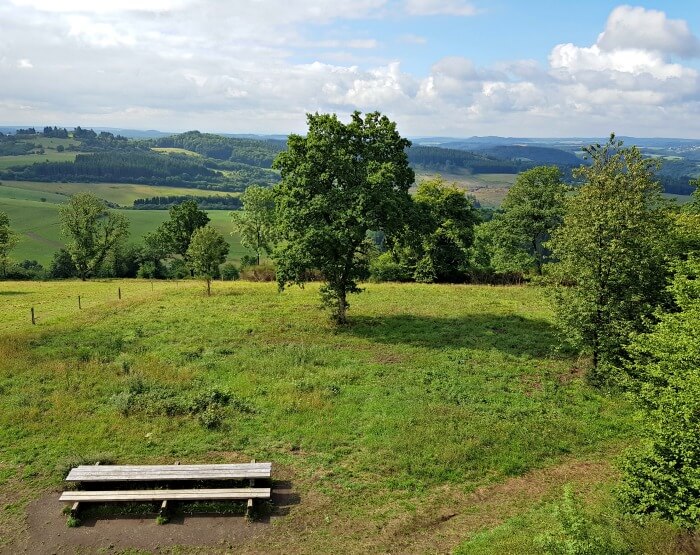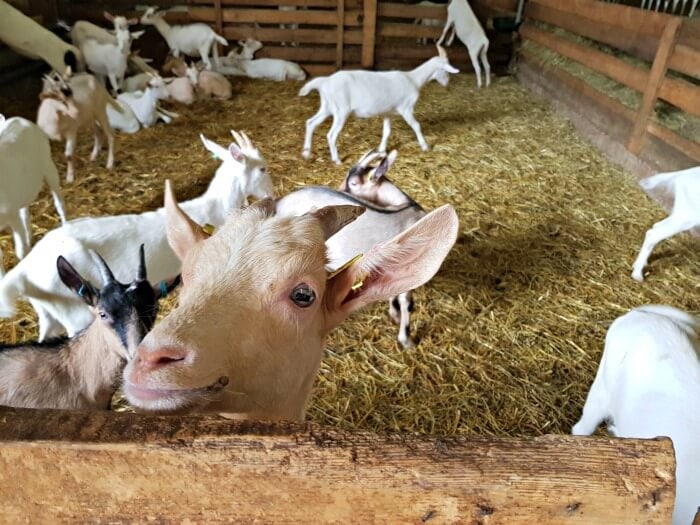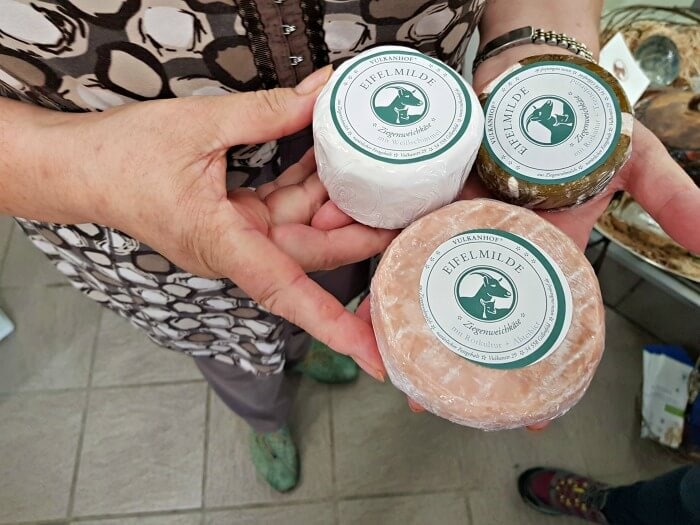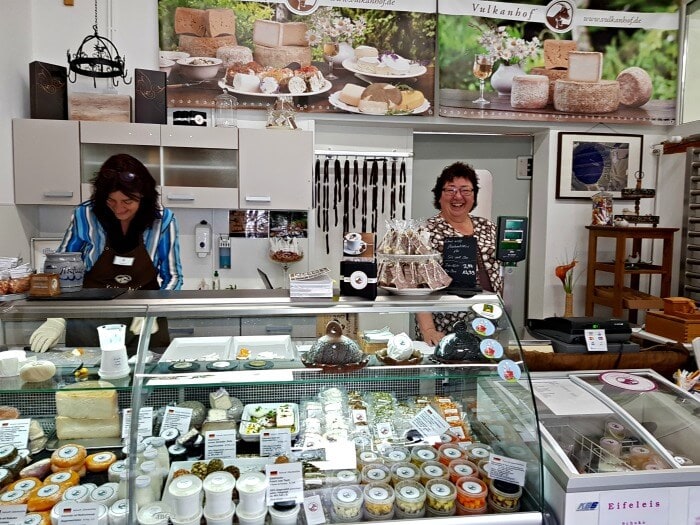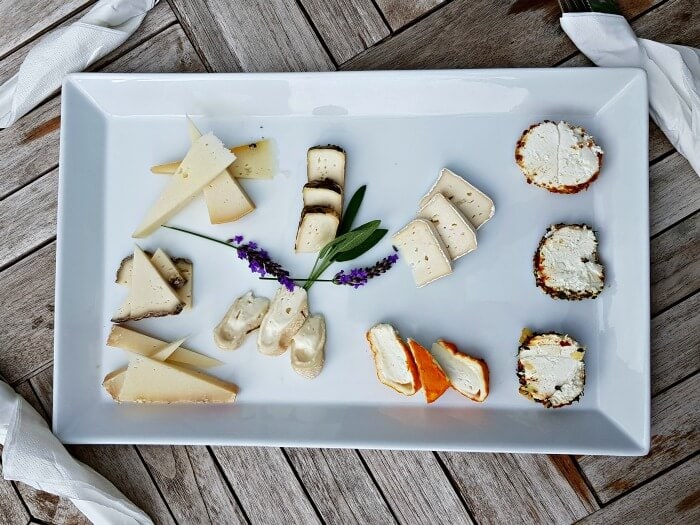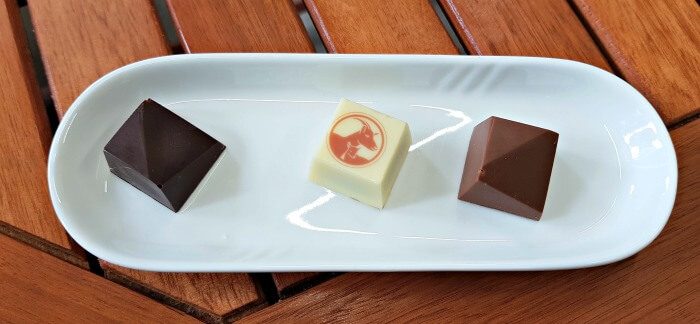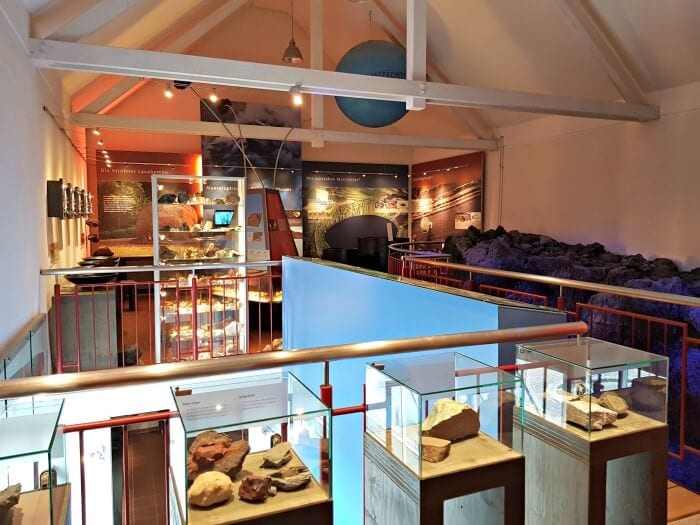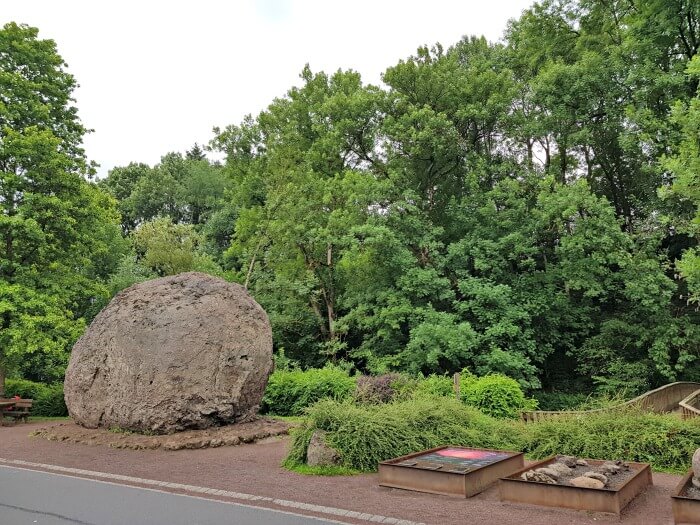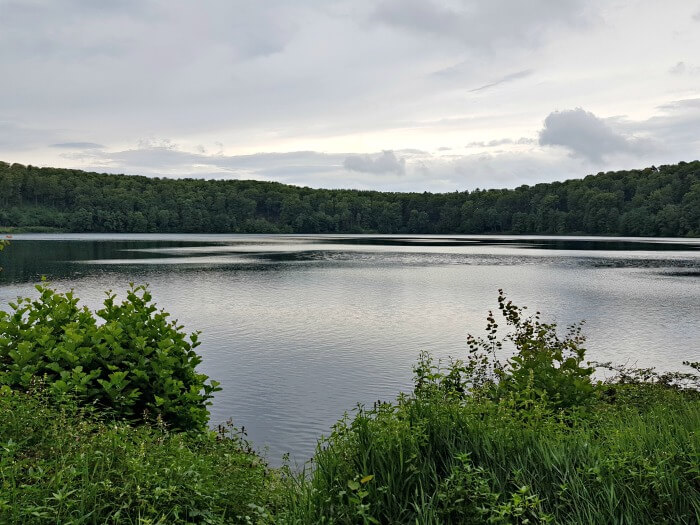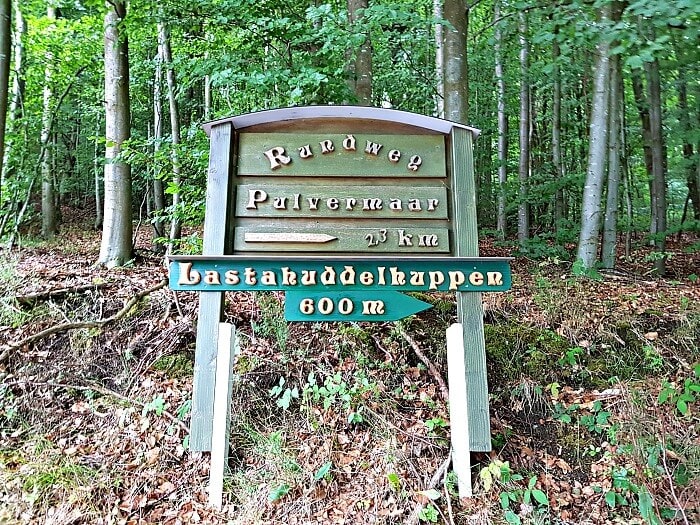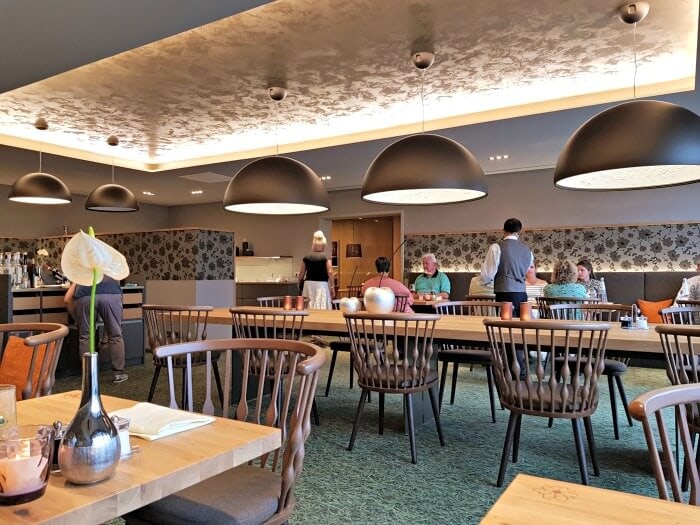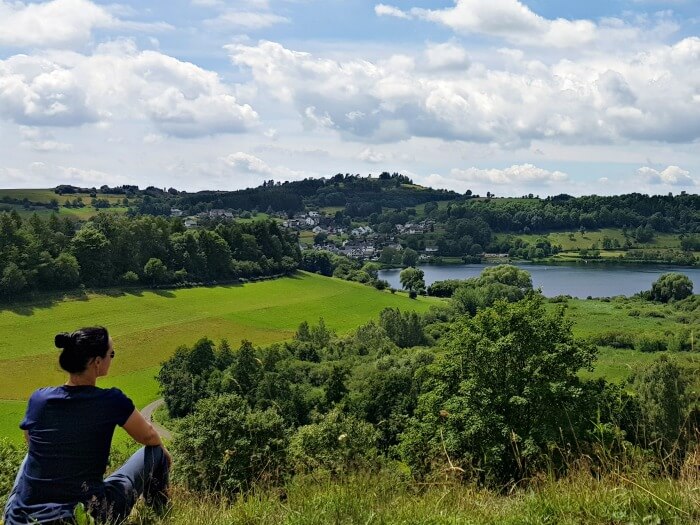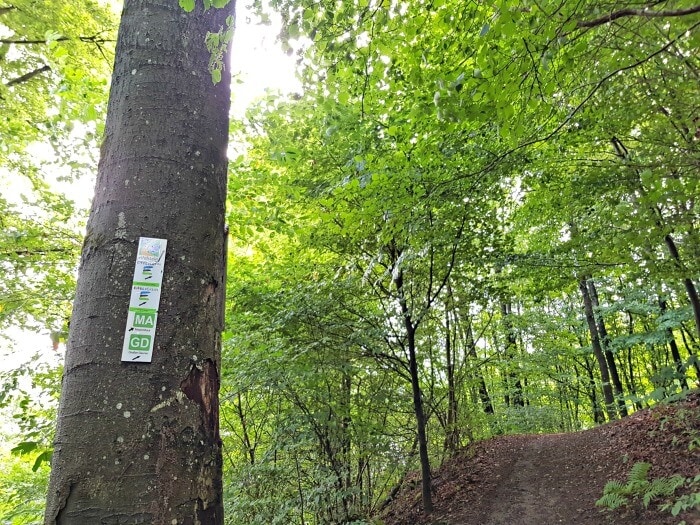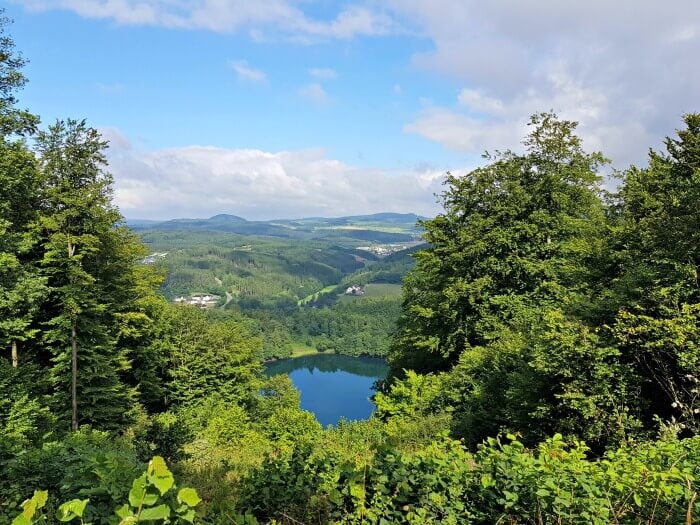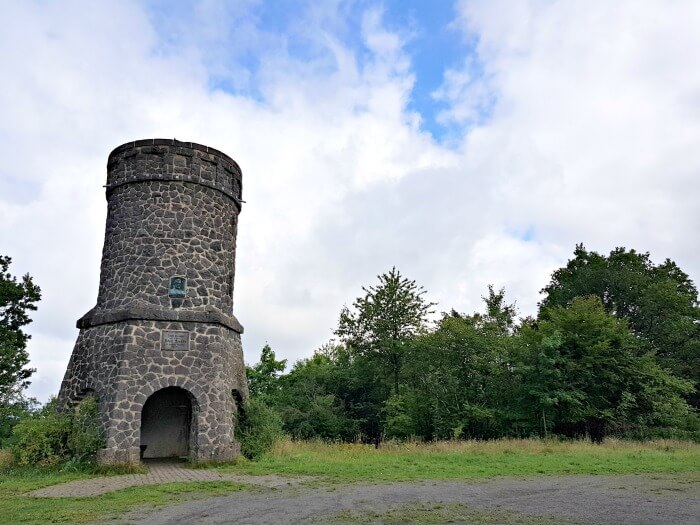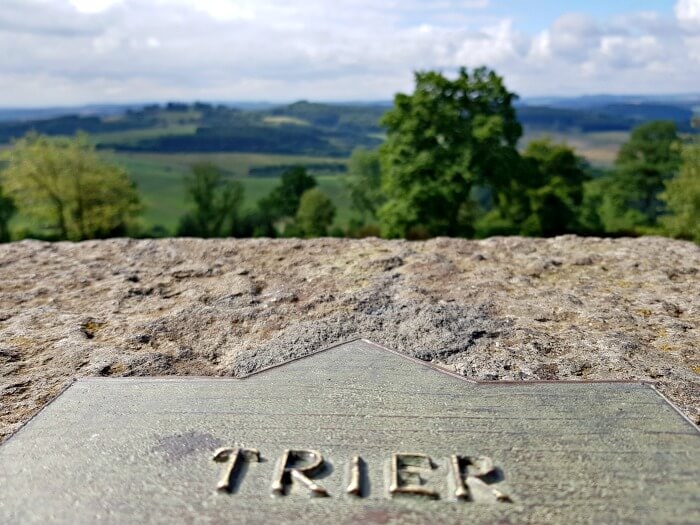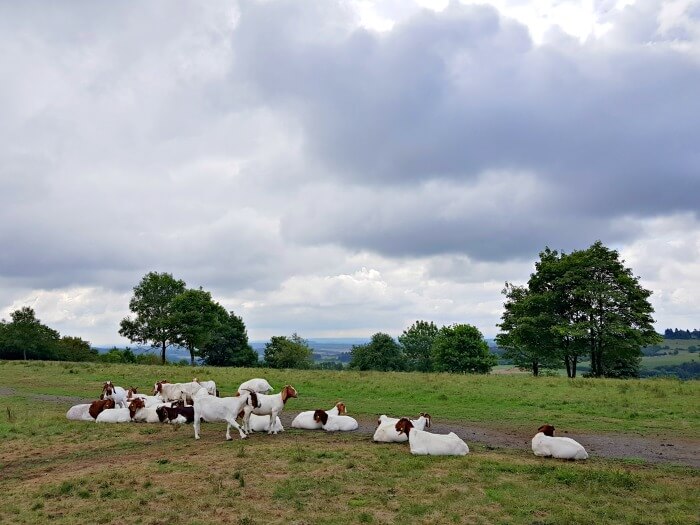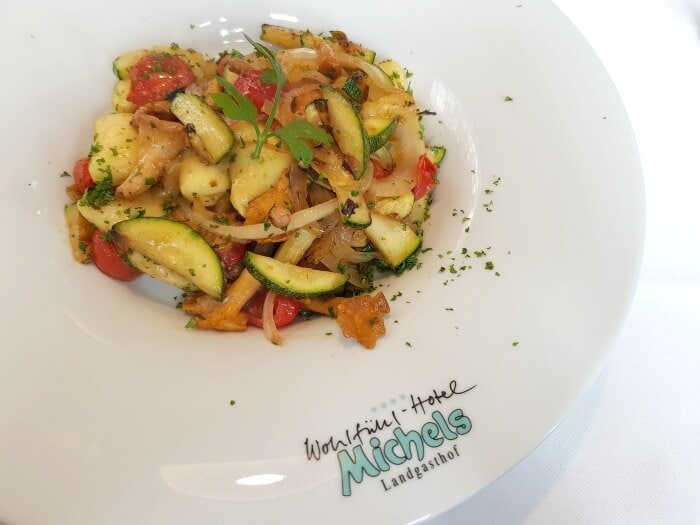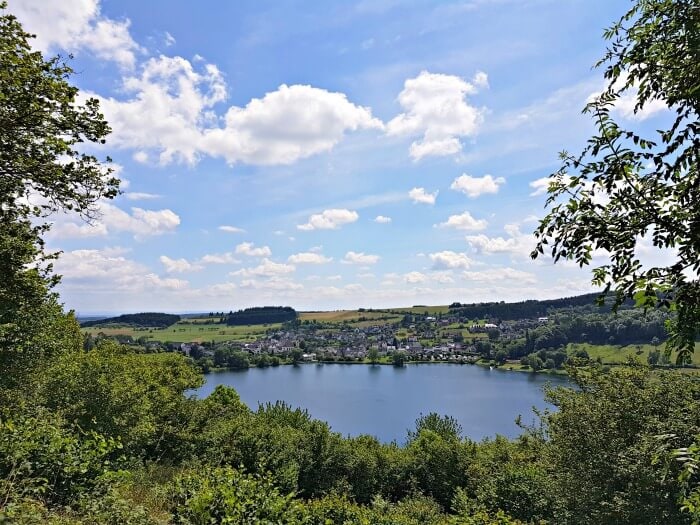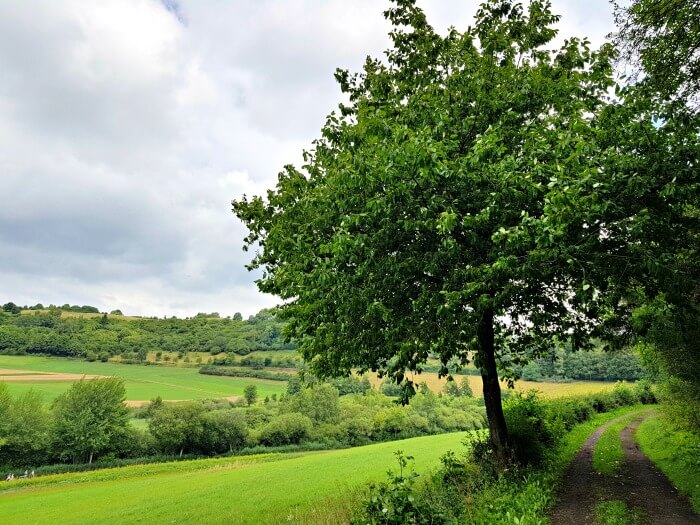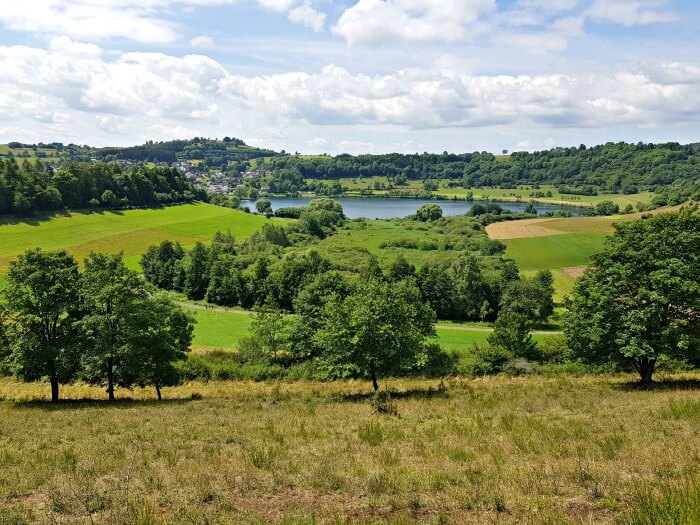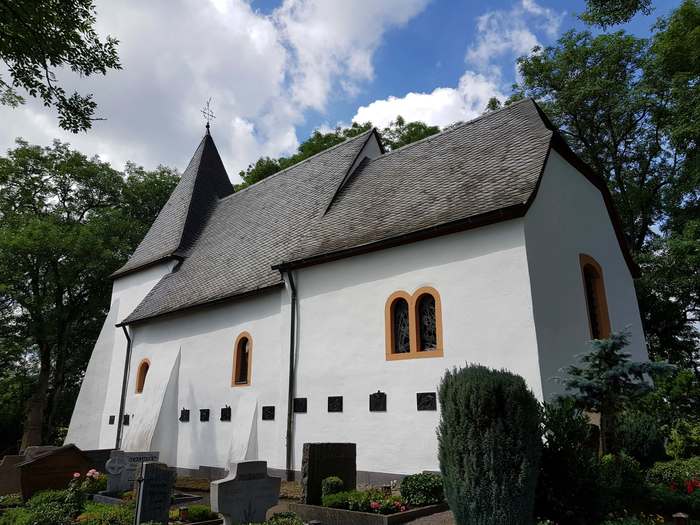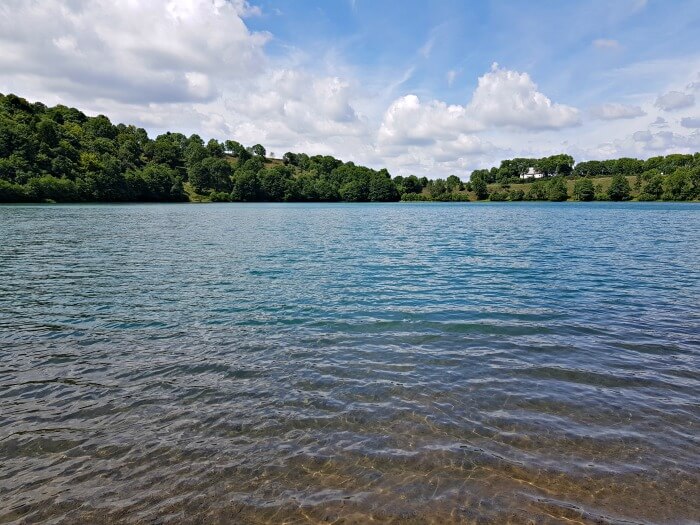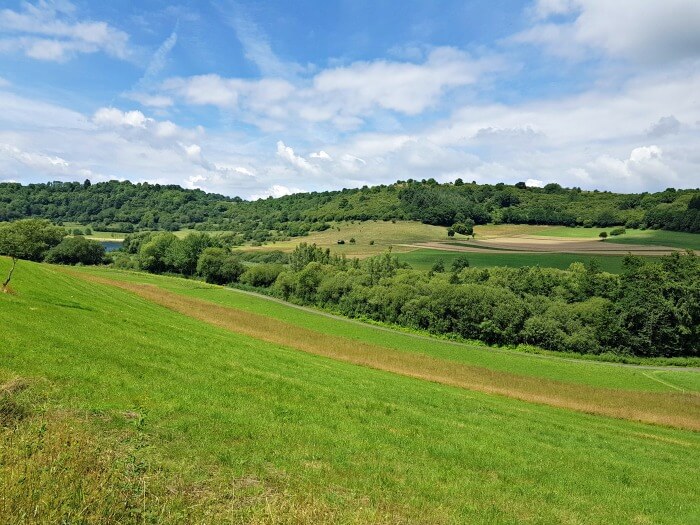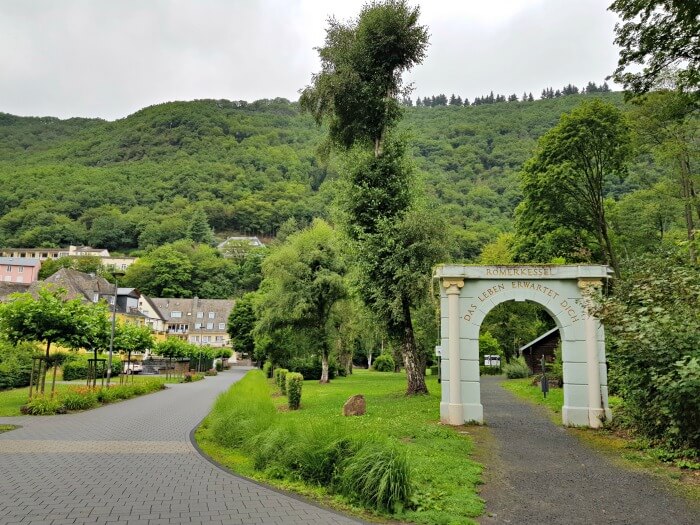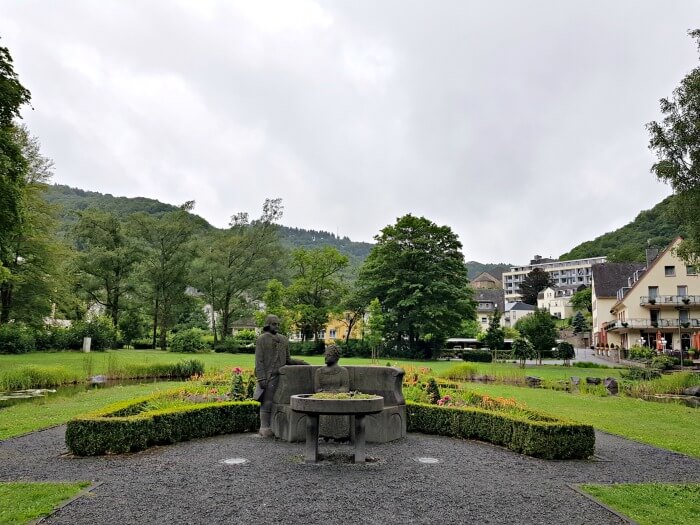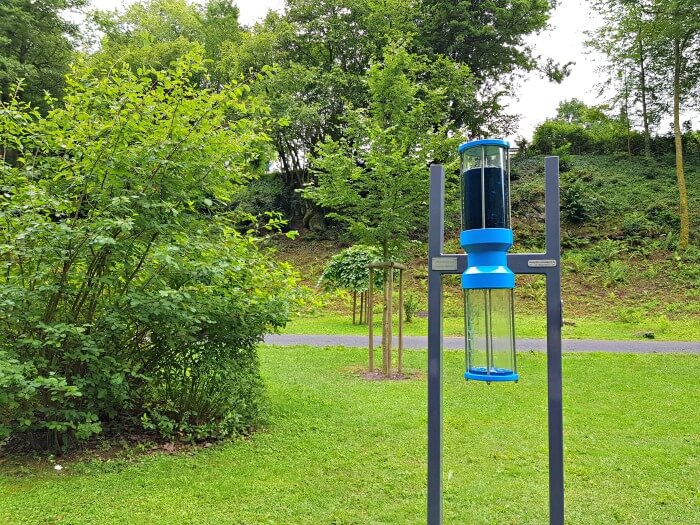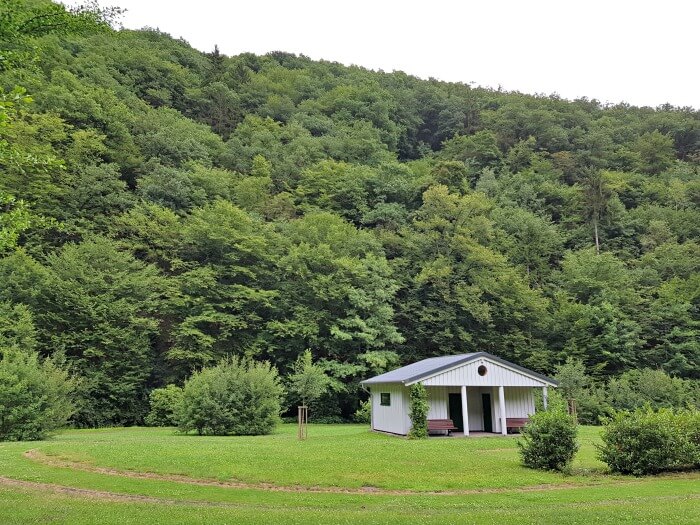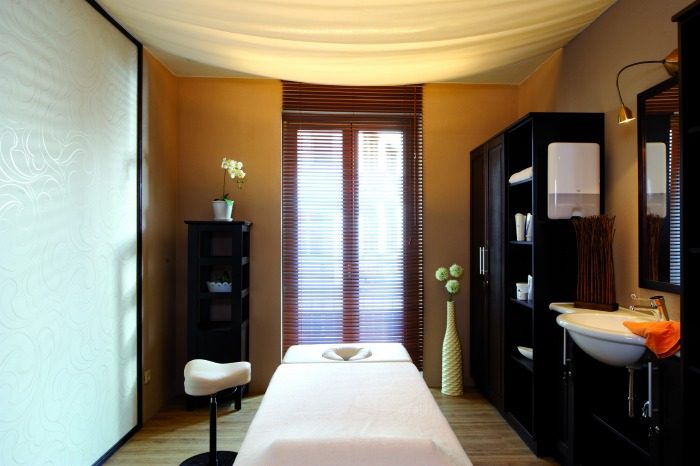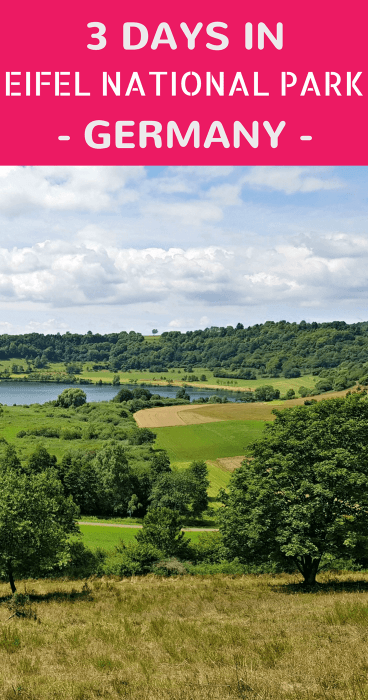When I was invited to visit the Eifel Volcano Region, I didn’t know what to expect.
In the past few years, I’ve made quite a few trips to Germany, but I always visited cities. I went to Münster (twice), ate my way around Cologne and traveled to Dresden.
So when the Gesundland Vulkaneifel – the tourism board for the Volcanic Eifel part of the German Eifel – invited me over, I was curious. It was the perfect opportunity to visit this amazing natural area and maybe even some of the Eifel Volcano museums nearby. Of course, I had to say yes.
Below is what I did during my three days in the German volcano region, including practical information.
3 days of things to do at the Eifel Volcano Region in Germany: day 1
A cheesy lunch at goat farm Vulkanhof – Ziegenkäserei
I arrived at the Vulkaneifel in the morning. After having checked into the hotel, I drove to my first stop: goat cheese farm Vulkanhof. There, Kathrin from the tourism board and I met with the lovely Inge, who runs the farm together with her family.
Inge’s parents built the farm themselves in 1960 but back then they kept pigs and cows. When Inge took over the business in 1985, farming had already started changing. If pig and cow farms wanted to keep up with demand, they needed to grow bigger, which meant a huge investment for the farmers.
Inge didn’t want to expand and send her cow milk off to some factory to have it processed. She wanted to keep things small, in-house, and personal. A long-time friend suggested she switch the pigs and cows for goats, and so she did in 1995.
Every morning and evening, Inge’s son-in-law milks the goats. The milk then goes into their processing room, where it’s turned into cheese. All of this happens manually, even the stirring of the milk, to maintain the milk’s original texture.
No additives are used either. The Vulkanhof’s cheese is pure, natural cheese. The many different flavors are due to things like the aging and wrapping process.
We learned all of this during a tour around the farm, which you can also book yourself. At the time of writing this post, you can book a spot on the tour for €17 per person.
If you’re visiting during a school holiday, you can join one of their open guided tours, or you can simply roam around the farm yourself without getting the explanation. Inge told me many people do that as they mostly want to see the cute goats.
The Vulkanhof has its own little store, and they also sell their cheese in other stores and restaurants.
While we waited for our lunch, Inge told us that she even has a Belgian family that visits three times a year to buy huge amounts of their cheese to then sell it onward in Belgium.
Lunch? Yes, you can have lunch at the Vulkanhof! They have a lovely little terrace but as the weather was a bit dodgy, we opted for the table inside which we shared with an older couple who came in for lunch as well.
For lunch, you can order a tasting plate full of different kinds of cheeses from the farm, paired with some bread. It was so good and so filling. Especially with that goat milk ice cream and those goat cheese pralines I had after :-D
Fun fact: when Inge approached German chocolatiers to create pralines with her goat cheese (yes, with the cheese!), they weren’t sure if they could do it, so she went to a Belgian chocolatier and he’s been making pralines for her ever since.
Vulkanhof – Ziegenkäserei
Vulkanstr. 29
54558 Gillenfeld
0049 6573 9148
info@vulkanhof.de
Everything about volcanoes in Germany at the Vulkanhaus Strohn
Next up was the Vulkanhaus in Strohn. The Vulkanhaus is one of several geo-museums in the Vulkaneifel park that serves as an information point for those who want to learn more about the evolution of the volcanic park throughout the times. Each museum has a different focus and at the Vulkanhaus that focus is physics.
I don’t know how it is in the other museums, but I thought it was a bit of a shame that all the information panels at the Vulkanhaus were in German. Now, I can read a bit of German, but when scientific terms are involved, it becomes hard to understand everything.
For kids, it might be fun regardless of the language barrier, as several installations let visitors see, smell, and touch things.
Practical information
The website still lists the opening times and dates for 2016, but if their opening hours on Google Maps are up to date, it seems these haven’t changed. They are:
- April – October: from Tuesday until Sunday, from 10 a.m. until 5 p.m.
- November – March: from Tuesday until Sunday, from 1 p.m. until 5 p.m.
The entrance fee is €3 for adults, with discounts for families, students, kids, seniors, and people with disabilities.
Vulkanhaus Strohn
Hauptstrasse 38
54558 Strohn
0049 6573 953721
info@vulkanhaus-strohn.de
A lava bomb
From the Vulkanhaus it was a short drive (you can even walk, but it was raining when I was there) to the Strohner Lavabombe. The Lavabomb has a diameter of almost 5 meters and weighs no less than 120 tons. It came loose during the (controlled) explosion of a nearby quarry in 1969. The people of Strohn used a bulldozer to get it to where it is now.
So why is it called a lava bomb? Well, closer examination showed that it once was part of the Wartgesberg Volcano. During an eruption, it broke loose and rolled back into the crater, dragging along hot lava. This happened a few times until the rock became as huge as it is today. As the volcano stopped erupting and time passed, the rock became part of the landscape, only to appear again during the explosion of the quarry.
Lavabombe Strohn
Zur Schweiz
54558 Strohn
A walk around volcanic lake Pulvermaar
After having learned a bit about the region, it was time to go explore it on foot. I drove to the Pulvermaar, one of the lakes in Germany known for being volcanic and part of the Vulkaneifel Maare or “Volcanic lakes of the Vulkaneifel”.
The word “Maar” comes from the Latin word for “lake” but nowadays it’s a scientific term to indicate lakes of a volcanic origin that are filled with groundwater. Many of the Maaren in the region aren’t recognizable as such anymore because they dried up.
The Pulvermaar can easily be reached by car. There’s a bar with an outdoor swimming pool right by the lake, for which I listed the address below. If you drive there, you’ll arrive at a large parking lot that ends where the hike around the Pulvermaar starts.
It’s an easy hike of a mere 2.3 km and it starts at this sign:
The hike is more of a regular walk. It goes right around the lake on relatively flat terrain. The dirt path is wide, without any rocks or roots you could trip over. Near the end, you can descend toward the water and follow a narrow branch of the path for a few meters to get a good view of the lake. It’s an easy path as well, but because it’s narrow, it’s not doable in a wheelchair. Don’t worry though: you can also just follow the road back to the parking lot.
Freibad “Am Pulvermaar”
Auf der Maarhöhe
54558 Gillenfeld
Dinner at Hotel Panorama
On my first night at the Volcanic Eifel, I had dinner at Hotel Panorama. It’s named as such because it’s located high upon a hill in the town of Daun, which it overlooks from its large terrace.
As it was raining terribly when I arrived, I had dinner at the spacious restaurant. I loved the modern interior of the place and can recommend the food.
Hotel Panorama
Rosenbergstrasse 26
54550 Daun
0049 6592 9340
Day 2 in the Volcanic Eifel: The Three Lakes Hike
After a good night’s sleep, I was ready to tackle a larger hike. The plan for the day was to walk the 8.9 km route around three volcanic lakes: the Gemündener Maar, the Weinfelder Maar, and the Schalkenmehrener Maar.
This three lakes hike is part of the Eifelsteig, a 313 km-long hiking route through the Eifel region of Germany and Belgium. It runs all the way from Aachen to Trier. The Eifelsteig is signed the same way everywhere with the logo you can see at the top in the following photo.
And there’s more hiking you can do at the Vulkaneifel park because aside from the Eifelsteig, there are also the Vulkaneifel-Pfade or the “Vulkaneifel Paths” – good for a total of 380 km.
But back to our route!
You can basically start this hike anywhere along the route, but because of its proximity to where I was staying, I started at the Gemündener Maar. There’s a cafe with a lovely terrace near the Badestrand – the KuliMaarik. If you drive there, you’ll reach two parking lots where you can leave your car to start the walk.
You can walk in either direction. I decided to go counter-clockwise which immediately took me uphill. I didn’t see too much of the lake below me until I reached a high point, from where the view was pretty cool. It would get better a few minutes further down my hike, though, when I reached the Dronketurm, a tower that gives you a 360° view of the area, well beyond the Gemündener Maar.
There’s also a cute wooden swing chair and a picnic table if you need to sit down for a bit.
From there, I walked onward to the Weinfelder Maar. The first part led me through a pasture where goats decided to take a rest right on the path. No problem, I could easily go around them.
The path started to go downhill a bit again until I got a clear view of the Weinfelder Maar.
After you’ve passed the Weinfelder Maar, you need to cross the L64 road to get to the path around the Schalkenmehrener Maar. The very beginning of the path around this lake – the part to the right when you have your back to the Weinfelder Maar – was the only part where I felt I needed the hiking shoes I was wearing.
Most of this hike goes over a well-maintained dirt path. You can perfectly wear your (sturdy) sneakers for it unless it has been raining and you don’t want them to get muddy. The descent toward the Schalkenmehrener Maar, though, was quite steep and slippery. This was only so for a few meters though. After those, the path became wide and very easily walkable again.
At the back of the Schalkenmehrener Maar, the route briefly leaves nature and heads into the town of Schalkenmehren to take you to Michels Wohlfühlhotel & Restaurant where you can have a proper lunch. That’s what I did!
There are a few other cafes and restaurants in the town as well, so feel free to take your pick. Michels is just the one that’s an official part of the route.
With a full tummy, I headed back, now walking along the other sides of the lakes. It didn’t take me long to be in awe of the view I now got on the Schalkenmehrener Maar. In hindsight, the part walking back along that lake was the nicest part of the hike. It went from amazing views of the lake to gorgeous sights of the colorful farmland behind it.
When I crossed the L64 again, I could descend down toward the shore of the Weinfelder Maar. The first part of the hike around this lake was a bit higher up but the second part allows you to stop, dip your toes in the lake, or even go for a swim.
I walked on because Kathrin from the tourism board had told me about something I wanted to try for myself.
When you walk around the Weinfelder Maar, you can talk a path upward to get to the Weinfeld Church. This small church is rather special because anyone who visits can ring the church bells. And so that’s exactly what I did.
A lady who was also visiting tried to tell me something about the bells in German. I think she was saying that you’re supposed to ring them after you’ve prayed, but I’m not sure I understood that correctly.
After I’d passed the church, it was an easy walk back over a normal road to where I left my car.
A few things
- I didn’t think hiking boots were necessary for this hike, but it is a good idea to bring sturdy shoes.
- At the Eifel National Park, hiking is one of the main activities, yet I didn’t see that many people during my hike, and it was the high season. I loved how peaceful it was on the paths.
- There are only eight official volcanic Maare and the lakes on this hike are three of them. It’s pretty cool to imagine that you’re kind of walking through a volcanic field :-)
- There’s an app both for Android and for iOS called “Wandertouren Rheinland-Pfalz” on which you can find multiple routes for the region.
Landgasthof Michels
Sankt-Martin-Strasse 9
54552 Schalkenmehren
0049 6592 9280
You can find technical details and a map of the route here.
Dinner at the Grafenwald Resort & Sporthotel
My second night in the Vulkaneifel, I had dinner at the hotel I was staying at, the Grafenwald Resort & Sporthotel. It’s a big hotel which doesn’t just have rooms, but also studios and cottages. There’s an indoor swimming pool, a spa, a fitness center, and a kids club. You can also make use of the tennis fields or squash terrains.
I stayed in a studio that had a small kitchenette and a balcony overlooking the domain.
The hotel serves a breakfast buffet between 7 and 11 a.m., which is later than most hotels. Food and drinks can be ordered both at the restaurant and the bars around the clock. Dinner is a buffet as well.
Grafenwald Resort & Sporthotel
Im Grafenwald 1
54550 Daun
0049 6593 7130
Check prices for the Grafenwald
Day 3: Wellness in Bad Bertrich
After two rather active days, it was time to explore another side of Eifel region tourism – the wellness side. To do that, I drove to Bad Bertrich.
A walk through a therapeutic garden
In Bad Bertrich, I met with my guide Anita right outside the Bad Bertrich Tourismus office. In the following hour, she’d tell me all about the first landscape therapeutic park in Europe, park Römerkessel.
It’s a park with seven different thematic gardens which allow you to take a step back and have a look at your lifestyle and your health. Based on the landscape therapy coming from the United States, this isn’t a garden to rush through. Instead, you have to walk through it while being conscious of all of your senses.
The first garden we stopped at was the baroque garden which kind of entails the idea of karma: when I’m happy and radiate happiness, happiness will come back to me. But it’s also the garden that shows us it’s important to allow yourself beauty, fun, and a bit of fanciness. It’s a garden that focuses on lifting your spirits up.
The herb garden is shaped like a shell and delineated by stones that symbolize the cell membrane that protects our cells from whatever is outside of them. They stand for the safety the garden offers us and are based on the idea that everyone needs a place where they can fully be themselves and feel safe.
The herbs are there to remind us that nature takes care of us by providing all we need to take care of ourselves.
The relaxation garden invites you to hit pause. It has a huge hourglass that indicates five minutes. The idea is that you turn it around and are simply still for those five minutes. Don’t look at your phone, don’t talk. Just be.
In the movement garden, a barefeet track and a running track invite people to get moving as both the body and the mind need exercise to stay healthy.
The terrace garden speaks to our fantasy and creativity. It reminds us that as children, our fantasy has no limits. It was only once we started going to school that we were told to sit still and conform to the norm. We experienced a shift from being “feeling people” to being “thinking people”. It’s important to find triggers that allow us to be creative again and to keep our fantasies alive.
Lastly, the silent garden is located right next to the communal burial ground and has a path walking around it. This is a reference to the philosophers who walked in rounds while they were contemplating life and death. It’s a place that gives you the space and silence you need to think about life. The idea behind that is that when you accept that your life is finite, it’ll be easier to relativize things.
Therapeutic park Römerkessel
Am Römerkessel
56864 Bad Bertrich
For a tour, contact Anita Otten at 0049 2678 1321 or via email at otten.anita@t-online.de.
The park itself is free to visit.
A relaxed ending at the Vulkaneifel Therme Bad Bertrich
However unique the therapeutic park, the main attraction of Bad Bertrich is the Vulkaneifel Therme, a large spa complex with swimming pools, saunas, lounges, a steam bath, restaurants, a solarium, and a treatment area.
It’s famous because the water used at the spa comes from Germany’s only glauber salt source, which has medicinal powers.
It was the perfect place to go as the rain poured down after my walk through the park. I enjoyed a relaxing harmony massage before checking out the rest of the spa and ordering a healthy salad (followed by cake ;-)) at the pool bar.
If you want to spoil yourself as well, make sure to bring a bathing suit and slippers. You can rent towels and a bathrobe there if you like, or bring your own.
For prices and opening times, it’s best to check the website.
Bad Bertrich Vulkaneifeltherme
Clara-Viebig-Strasse 3-7
56864 Bad Bertrich
www.vulkaneifeltherme.de
Parking tip: when you enter Bad Bertrich, don’t follow your GPS to take the exit left to “Bad Bertrich West”. Instead, follow the signs for the Bad Bertrich Therme and take the second exit left when you’ve passed the first tunnel. It’s signed as “Vulkaneifel Therme”.
Good to know
The Vulkaneifel is not the same as the Eifel National Park. The National Park Eifel is 1 of 16 regions in Germany that have been declared German National Parks and it’s located in the north of the Eifel region.
The Eifel region as a whole is named after the Eifel mountains and extends across the border of Germany with Belgium.
The Vulkaneifel or “Volcano Eifel” lies in the center of the region and is characterized by volcanism. It’s also a UNESCO European Geopark.
The Gesundland Vulkaneifel, lastly, is a part of the Vulkaneifel that differentiates itself as a touristic region focusing on health, nature, and general wellbeing.
Confused by all these regions of Germany? Don’t worry, all you need to remember is that the Vulkaneifel is worth a visit! :-)
Don’t forget travel insurance
Plan for the best, prepare for the worst. Travel insurance has you covered in case (part of) your trip to the Eifel Volvano Region gets canceled, you get sick or hurt abroad, and sometimes even when your electronics break or get stolen. I always make sure I’m covered every trip I go on.
Don’t have travel insurance yet? Check out SafetyWing. They offer super flexible plans that you can even sign up for while you’re already on your trip. On top of that, they were the first travel insurance to cover COVID, and when I got COVID, they reimbursed all of my expenses without making a fuss. Their customer support team is great and I can personally recommend them.
PIN FOR LATER
I was invited by the Gesundland Vulkaneifel and Germany Travel to come and explore the region. As always, I was free to write what I wanted about this trip.

